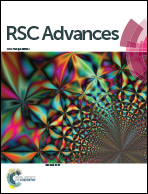Photocontrollable fluorogenic probes for visualising near-membrane copper(ii) in live cells†
Abstract
In this work, we have described the design, synthesis, and characterisation of photocontrollable fluorogenic probe, Mem-5, which is equipped with a photolabile group (nitrobenzyl group), high brightness reporter (fluorescein), and membrane-anchoring unit (cholesterol or long aliphatic chain). This probe shows an intense fluorescence enhancement in response to copper(II) without interference from 45 other analytes, including metal cations, amino acids, and anions, under biological conditions (pH 6–9). The hydrolysis reaction is second-order, with k = 9.01 × 10−5 M−1 s−1. The detection limit is 3.3 × 10−7 M in HEPES buffer (25 mM). The confocal fluorescence imaging results demonstrated that Mem-5 can visualise near-membrane copper(II) in live mammalian cells. The clear advantage of our photocontrollable method is that it successfully avoids the influence of chemical species outside cells during near-membrane specific detection.



 Please wait while we load your content...
Please wait while we load your content...